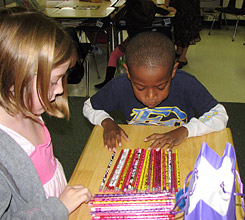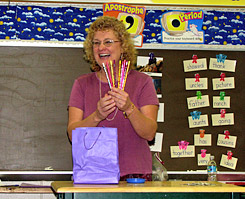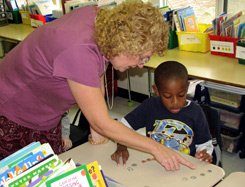Thinking About Change: Kids Use Coins to Learn
A classroom store teaches young students about money while reinforcing math skills.
Your content has been saved!
Go to My Saved Content.
At the front of the first-grade classroom at Sabal Palm Elementary School, in Jacksonville, Florida, there's a cart filled with colorful pencils. The writing implements are today's featured sale items in teacher Eileen Sheehan's classroom "store," and her students are eager to "buy" one.
"I want a pink one! I like pink!" exclaims one student as she carefully selects the combination of laminated coin images that will equal Sheehan's declared price for the pencil. This time, the item costs $0.27 -- but there's a catch: Students need to use at least two nickels to pay for it.
Sheehan, who has taught for seventeen years, observed early on in her career that teaching students about coins by using worksheets was not effective. "Worksheets didn't go well," she says. "The pictures of the money didn't look like money. They weren't easily identifiable. And kids can't manipulate the pictures of money on a worksheet or actually buy something."
So, Sheehan opened a classroom store to build student interest and make the learning process more appealing.
What Students Learn
Sheehan says challenging students to use certain groupings of coins to buy items from the classroom store is a playful and engaging way for them to meet state first-grade curriculum standards for learning coin values and equivalencies. It also focuses students on real-world situations that require them to apply the math skills they developed earlier in the school year.
"With the store, kids are counting by fives and tens, and then combining with ones," explains Sheehan. "You can see them thinking, 'I need more' or 'I need less.' It helps them with addition and subtraction, and it makes them good problem solvers, too, because they see there are different ways to do it."

Getting an item from the store in exchange for correctly solving a problem boosts each student's intrinsic motivation for learning about money. Students immediately recognize the usefulness of knowing the value of each coin and can connect what they are doing with their own shopping experiences outside of the classroom. Sheehan also makes the prices and required coin combinations increasingly more difficult -- by adding quarters, for instance -- to keep challenging students and expand their higher-level reasoning.
Sheehan's classroom store remains open for about a month. She says that by stretching this in-depth exploration of money over a thirty-day period, she is able to get her students to think more deeply about important mathematical principles, and they retain what they've learned. "As they mature and hit different cognitive stages, it really clicks for them," notes Sheehan. "It just gives me goose bumps!"
How It's Done
Sheehan operates the classroom store for hour-long sessions about three days per week. She begins by getting out the class set of laminated coin images and then has students pick up a specific number of coins for that session's purchases. This time, each student gets six dimes, four nickels, and four pennies.

Next, Sheehan begins the first purchasing round by showing students the featured item from the store's inventory and writing its price on the board. In the beginning, she just posts a number with a cent sign and lets students combine coins however they like to match the amount. Once students are more confident, though, Sheehan will challenge them to match prices using particular combinations of coins. For example, in this round, the students must use two nickels to pay for the item.
By specifying which coins students have available to pay for items and which coin combination they need to use to reach the total, Sheehan can easily vary the level of difficulty for the activity and not overwhelm students.
Sheehan just recently opened the store for this year's class, so students are in the early stages of learning about coins and their equivalencies. She roams around the room, checking each student's answer. When she stops at William's desk and examines the coins he's chosen to use to purchase the pencil, together, they count out the coins and talk about their value. Once Sheehan confirms that he has the correct total, she sends him to the front of the room to choose his pencil. William then returns to his seat and puts the money he used to "buy" the pencil back with the original pool of coins on his desk so he'll be ready for the next round.
The inventory for the store includes a variety of simple objects donated by parents. In addition to pencils, the stock includes plastic fish, stickers, marbles, and toy soldiers -- even individual cotton swabs will sell. "I can never guess what items will be popular," admits Sheehan. "A lot of times, the kids come up with creative uses for common objects. Or they will give it to someone at home or trade with fellow students for other things."
To help you successfully replicate this project in your classroom, Sheehan suggests the following practices:
- Fake the money. Use things that look like real coins, rather than actual coins. One free source of such fake money is abcteach's Coins for Teaching Math page. Print the coins in color, laminate them, and cut them out to build a class set you can distribute and collect during each store session.
- Start big and go small. Reinforce the strategy that students should move toward their target price by starting with the coin that is worth the most. Note: Young students can get confused because nickels are bigger than dimes but are worth less. With frequent practice, however, students will recognize that size does not necessarily indicate value.
- Do the project later in the year. Teach money to first graders in the third quarter, when students are more mature and have stronger number sense and addition and subtraction skills.
- Give reassurance. Explain to students that they might not figure out how to correctly combine coins to buy every store item, but if they put forth a good effort, you will help them.
- Challenge everyone. Balance out the range of ability levels in your class by giving students a choice of two prices or coin combinations to match. For example, tell students that one problem is for those who may want more of a challenge, and the other is for students who feel like they need some more practice.
- Talk the talk. Use vocabulary words that relate to the study of money. For example, say, "This is going to be expensive!" You will find that students start to copy your vocabulary and build language skills.
- Use with students in other grades. Extend the activity to higher-grade levels by having students make change. For kindergartners, focus on coin recognition by giving them a pile of coins and then asking them to pull out a dime.